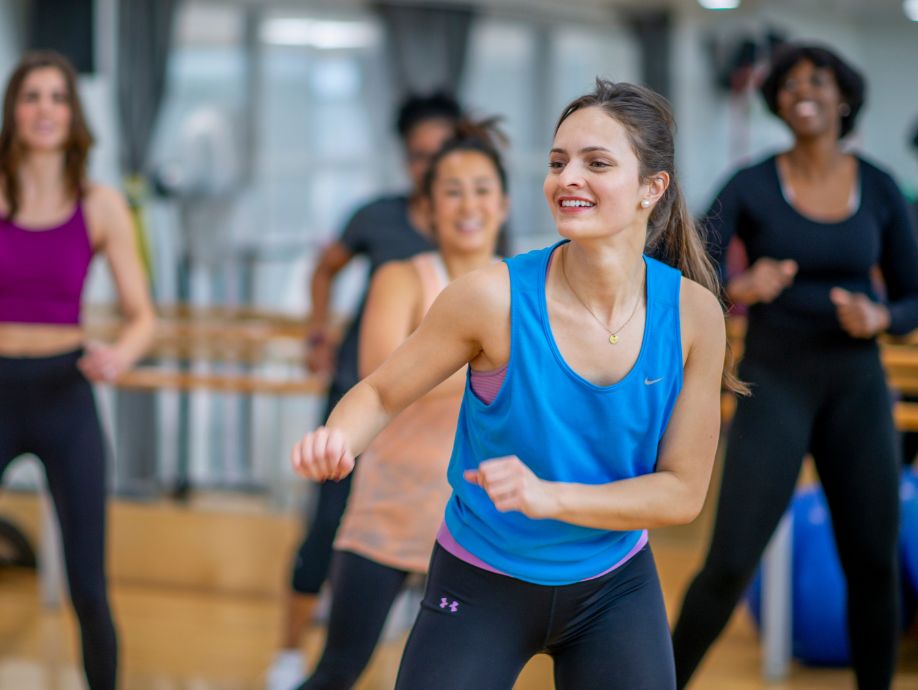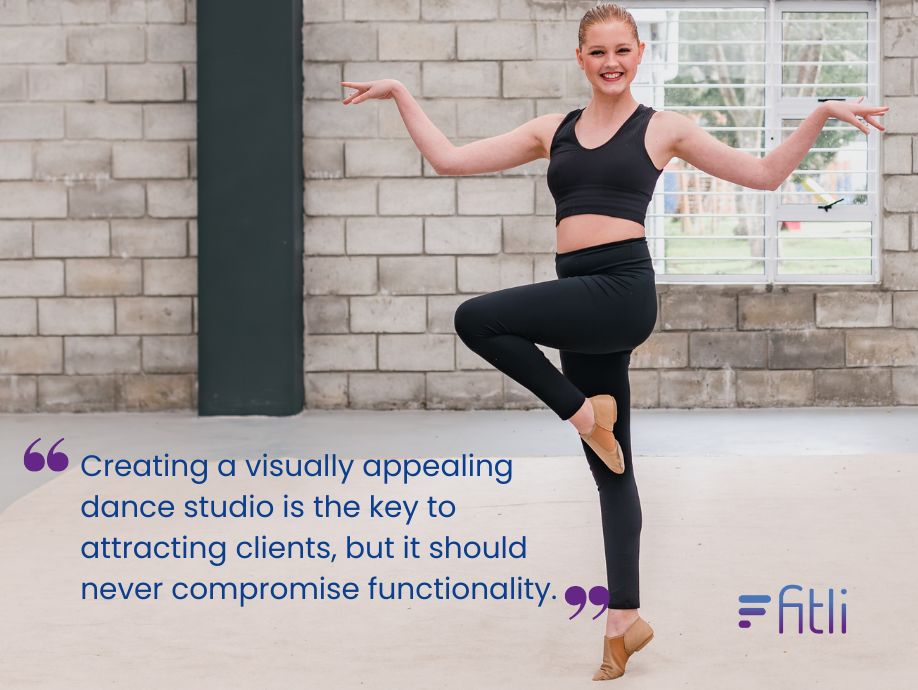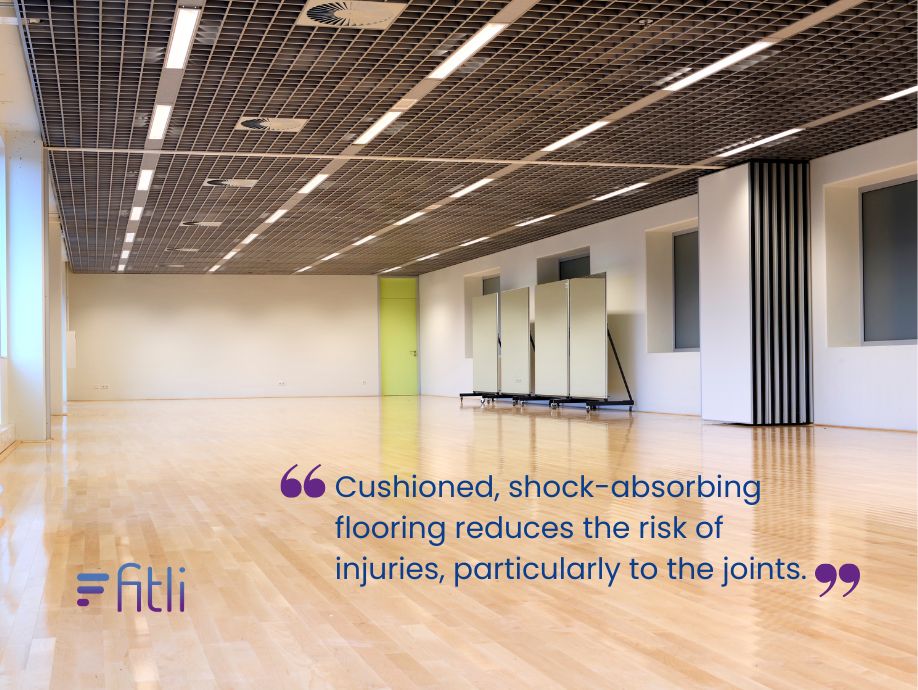Dance Studio Design Requirements
A well-designed dance studio not only ensures the safety and comfort of your clients but also contributes significantly to your business’s overall experience and success. Here are key elements for creating a safe and injury-preventive dance studio environment:
1. Flooring
One of the fundamental aspects of dance studio design requirements is the choice of flooring. For fitness dance activities like Zumba and Barre, a cushioned, shock-absorbing floor reduces the risk of injuries, particularly to the joints.
Consider options such as sprung flooring, which offers excellent shock absorption, or specialized dance flooring, like Marley, designed to provide the ideal surface for dancers’ movements. The flooring should also be non-slip to prevent accidents. Choose a material that offers the right amount of grip, ensuring that dancers can execute their moves without fear of slipping.
2. Mirrors
Proper dance studio mirrors code requirements also need to be considered. Mirrors are indispensable in a fitness dance studio since they allow participants to monitor their form, posture, and movements and create a visually appealing space.
Mirrors should cover as much wall space as possible without overwhelming the studio’s aesthetics. Full-length mirrors are particularly valuable for dancers to observe their entire body while dancing. Strategically placing mirrors opposite each other can create an illusion of space, making the studio feel more expansive. This can be especially beneficial in smaller studio spaces.
When installing mirrors in your dance studio, you should be aware of any local building codes or regulations related to their size, placement, and safety. These codes are in place to ensure that mirrors do not pose any hazards and that they are securely installed to prevent accidents. Consult with a professional contractor or architect who is familiar with local building codes to ensure compliance and safety.
Dance Studio Mirrors Code Requirements
- Secure mirrors firmly to walls, not free-standing.
- Use rosin paper between the mirror and the wall to absorb shock.
- Place barres to avoid contact with mirrors during leaps or kicks.
- Install the mirror 16-22 inches above floor level.
- Position so contact with the mirror edge is unlikely during leaps or extensions.
- Mount side by side with minimal frame separation.
- Include anti-fall safety backing.
- Avoid proximity to heating or cooling vents, which might cause fogging.
3. Ceiling Heights
Ceiling heights are often overlooked but they are an essential component of dance studio design requirements. Adequate height provides room for vertical movement, allowing dancers to leap, jump, and perform lifts without limitations.
Low ceilings can limit the range of movements and poses, potentially leading to safety concerns and hindering the overall experience. Higher ceilings provide ample vertical space for dynamic movements and create an open, airy atmosphere.
A ceiling height of 20-24 feet is ideal, but 16 feet is the minimum height for dance studios to accommodate various dance styles and movements comfortably. Consider the aesthetics by adding ceiling fixtures that complement the studio’s theme and create an inviting atmosphere. Well-designed lighting can also enhance the overall look of your studio.
4. Ventilation and Air Quality
Proper ventilation and air quality are vital for the comfort and well-being of both clients and instructors. The physical exertion involved in fitness-focused dance can lead to increased perspiration and heat buildup. Good ventilation helps maintain a comfortable temperature and removes stale air, reducing the risk of overheating and discomfort.
Invest in a high-quality HVAC system that can efficiently circulate and filter the air. Adequate airflow also contributes to better air quality, ensuring that the studio remains a pleasant and healthy environment for all.
5. Balancing Between Aesthetics and Functionality
Creating a visually appealing dance studio is the key to attracting clients, but it should never compromise functionality. Striking the right balance between aesthetics and functionality is a continuous process that requires careful planning and design choices.
Consider using a color palette that aligns with the energy and vibe of fitness dance. Incorporate vibrant, motivating colors that energize participants. Add decorative elements like artwork or wall decals that reflect the dance theme while not obstructing the mirror space.
Furniture and storage should be selected with both aesthetics and functionality in mind. Utilize multi-purpose storage solutions that keep the space clutter-free without sacrificing style.
6. Layout
Dance studio design requirements call for a well-designed layout that defines separate spaces, such as instruction, rehearsal, recitals, storage, and locker rooms.
Utilize moveable partitions or curtains to modify areas as needed. Ensure there’s ample room around barres and between stations. The proper layout goes beyond aesthetics to functionality. It facilitates top-notch training, creativity, and performance in a secure environment.








